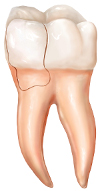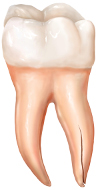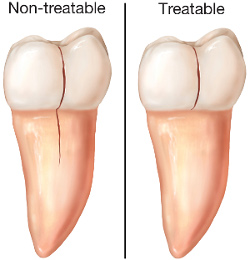My dentist told me that I might have a cracked or fractured tooth. What should I know about this?
Cracked teeth show a variety of symptoms, including erratic pain when chewing, possibly with the release of biting pressure, or pain when your tooth is exposed to temperature extremes. In many cases, the pain comes and goes, and dentists may have difficulty locating which tooth is causing the discomfort. When the outer hard tissues of the tooth are cracked, chewing can cause movement of the pieces, and the pulp (or nerve tissues) inside the tooth can become irritated. When biting pressure is released, the crack can close quickly, resulting in a momentary, sharp pain. Irritation of the dental pulp can be repeated many times by chewing. Eventually, the pulp becomes damaged to the point that it can no longer heal itself. Extensive cracks can lead to infection of the pulp tissue, which can spread to the bone and gum tissue surrounding the tooth. Unlike a broken bone, the fracture in a cracked tooth never heals. In spite of treatment, some cracks may continue to progress and separate, resulting in loss of the tooth. The root canal treatment you receive for your cracked tooth is important because it will relieve pain and reduce the likelihood that the crack will worsen. Once treated, most cracked teeth continue to function and provide years of comfortable chewing. Upon the completion of your root canal treatment, your family dentist will permanently restore your tooth with a crown. This crown provides maximum protection, but does not guarantee success in all cases. Talk to your dentist/endodontist about your particular diagnosis and treatment recommendations. There are many different types of cracked teeth. The treatment and outcome for your tooth depends on the type, location, and severity of the crack.
Examples of Cracked Teeth

Fractured Cusp

Split Tooth

Vertical root fracture

Cracked Tooth
